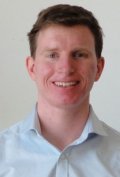 In this thesis Raleigh-Bénard (RB) convection was studied. Here, a layer of fluid is heated from below and cooled from above.
In this thesis Raleigh-Bénard (RB) convection was studied. Here, a layer of fluid is heated from below and cooled from above.
‘We developed novel numerical methods for simulation of RB convection,’ says Gijs Kooij. ‘With the rise of modern computers, direct numerical simulation (DNS) has become common practice. We first analyzed four such modern methods.’
Gijs observed large differences in computational costs, which illustrated the contrast between specialized and general codes. ‘We then focused on parallelization in time instead of parallelization in space,’ he says. ‘This is especially interesting as the number of cores in new supercomputers is still increasing. Above that, traditional parallelization in space might already be quite saturated, not leading to efficient parallel performance or large reductions of computational time.’
Therefore Gijs extended the already existing Paraexp algoritm towards nonlinear partial differential equations. ‘We first tested the method on the advection-diffusion equation,’ he says. ‘After that, the parallel method showed good efficiency for various viscosity coefficients, and for problems like in the well-known Burgers equation as well.’
Finally the so-called ‘exponential integrator’ of this algorithm was studied, which can solve homogeneous initial value problems very fast. ‘Several numerical experiments showed this method converges to the reference solutions of the incompressible Navier-Stokes equations,’ Gijs says. ‘Because the exponential integrator can be combined with properties of the algorithm I studied earlier in the PhD project, I suspect further parallel speedup is feasible.’
During his PhD project Gijs experienced several special moments. ‘It is a great feeling when after working minutely, and for long periods, on the algorithm codes, the program delivers the desired for solution,’ he says.
‘The algorithms we studied were initially taken from literature. The research procedure is broadly to first solve one dimensional linear problems, and then to expand these toward non-linear and 2D exemplary issues. If the solutions numerically converge in the end, the feeling is really rewarding.’
Publications
Gijs succeeded in publishing articles in high impact journals including: Journal of Computational and Applied Mathematics and International Journal of Heat and Fluid Flow. Also he was a speaker on big conferences such as ERCOFTAC (on fluid mechanics) and ECCOMAS (on computational methods in applied sciences).
‘During the PhD project you are gaining an independent research attitude and approach real quickly,’ he says. ‘The daily supervisors and promotors are no longer the experts on your field. You have become the expert yourself, leaving you with the new and exciting task to solve the problems yourself and leading research into the right direction.’
collaborations
As a member of the Multiscale Modelling and Simulation (MMS) Group, Gijs collaborated with the Mesa+ Group Physics of Fluids (PoF), the members of which were willing to share their knowledge and expertise on convection theory.
‘Also we collaborated with the Max Planck Institution of Göttingen,’ Gijs mentions. ‘These experts had generated a relevant code as well, which we were happy to evaluate on this subject of research. Within the University of Twente, the MACS (Mathematics of Computational Science) Group was a natural partner in research. Other Mesa+ Groups are more orientated toward nanotechnology issues than we are. On the yearly Mesa+ Day however, I got lots of attention for my work from colleague Mesa+ researchers.’
After his PhD, Gijs is starting a job at a consultancy company, going to work as a scientific software engineer. ‘They were looking for an algorithm expert, also showing various programming skills,’ Gijs says. ‘That profile fitted very well with my PhD work. I look forward on participating in the projects of the company, which will take several months up to a year. It is a great opportunity to find out how my skills may contribute to solving real-life issues.’
